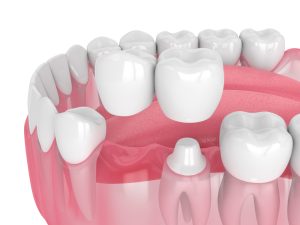Unveil the Perfect Tooth Replacement Solution
In the ever-evolving field of restorative dentistry, innovative solutions have emerged to address the challenges posed by missing teeth. Among these solutions, cantilever dental bridges stand out as a distinctive approach to tooth replacement. Unlike traditional dental bridges that rely on support from both sides of a gap, cantilever bridges offer a unique design by anchoring to only one adjacent tooth.
At Polasek Digital Dentistry & Schaefer Dental Group, our experienced Howell, MI, restorative dentist, Dr. Kyle Polasek, is dedicated to providing our patients with the latest and most effective dental solutions. Explore our comprehensive guide to cantilever dental bridges and discover how this innovative treatment can transform your smile by calling our Howell dental practice at 517-546-8983.
What Are Cantilever Dental Bridges?
A cantilever dental bridge is a specialized restoration used to replace a missing tooth when there’s only one adjacent supporting tooth. Unlike traditional bridges, which are held in place on both sides by dental crowns on the adjacent abutment teeth, a cantilever dental bridge only needs to be cemented to a crown on one side. The remaining natural tooth on the side of the artificial tooth is typically called the abutment tooth.
Cantilever bridges are typically crafted from a combination of ceramic and metal materials or entirely from ceramic, offering a natural-looking and durable restoration. They are often utilized to replace missing front teeth.
Benefits of Cantilever Dental Bridges
Cantilever dental bridges offer a range of benefits, including:
- Minimal Tooth Preparation: Unlike traditional bridges, cantilever dental bridges require minimal reduction of adjacent teeth. This approach preserves more of the natural tooth structure, promoting better long-term oral health.
- Preservation of Tooth Integrity: By minimizing the alteration of adjacent teeth, the risk of damaging healthy tooth structure is significantly reduced, leading to improved overall dental health.
- Effective for Small Gaps: Cantilever bridges are particularly useful when replacing a single missing tooth or in cases where there’s only one tooth adjacent to the gap. This makes them a practical solution for specific tooth replacement scenarios.
- Simple Procedure: The placement of a cantilever bridge typically involves a simpler procedure compared to more complex options like implant-supported bridges, resulting in a quicker and less invasive treatment process.
- Cost-Effective: Cantilever bridges can be a more cost-effective option compared to some alternatives, making them an accessible choice for patients with budget constraints.
- Less Healing Time: Since the procedure is less invasive, patients often experience shorter healing times and less postoperative discomfort, allowing for a quicker recovery and return to normal oral function.
The Cantilever Dental Bridge Process
- Initial Consultation: Schedule an appointment with Dr. Polasek to discuss your tooth replacement needs. During the consultation, our dentist will evaluate your oral health, the condition of adjacent teeth, and the gap that needs to be filled.
- Treatment Planning: If a cantilever bridge is deemed suitable, Dr. Polasek will develop a comprehensive treatment plan, including considerations for the bridge design, material selection, and the overall approach to the procedure.
- Tooth Preparation: On the day of the procedure, a local anesthetic will be administered to numb the area around the missing tooth and adjacent teeth. The adjacent tooth that will serve as support for the cantilever bridge will be prepared by removing a small amount of enamel to create space for the bridge.
- Impression Taking: Once the tooth is prepared, Dr. Polasek will take precise impressions of your teeth. These impressions will be used to create a mold, which will be sent to a dental laboratory for the fabrication of your custom bridge.
- Temporary Bridge Placement: While your permanent bridge is being created, a temporary bridge may be placed to protect the prepared tooth and improve aesthetics.
- Bridge Fabrication: A skilled dental laboratory technician will use the impressions to craft a custom-made cantilever bridge designed to match the color, size, and shape of your natural teeth for a seamless appearance.
- Permanent Bridge Placement: Once the permanent bridge is ready, you’ll return to our office. The temporary bridge, if placed, will be removed, and the new cantilever bridge will be carefully fitted and adjusted as needed.
- Bonding: The bridge will be securely bonded to the prepared adjacent tooth using dental cement, ensuring a comfortable fit and proper bite alignment.
- Final Adjustments: Dr. Polasek will make any necessary final adjustments to ensure your new bridge feels comfortable and functions properly when you bite and chew.
Is a Cantilever Dental Bridge Right for You?
Dr. Polasek may recommend a cantilever bridge for patients in the following situations:
- Single Missing Tooth: Cantilever bridges are an ideal option for individuals with a single missing tooth, especially when there’s only one tooth adjacent to the gap that can serve as support.
- Adjacent Tooth Strength: The adjacent tooth chosen for support should have good structural integrity and be free from significant dental issues like tooth decay, gum disease, or extensive restorations.
- Small Gaps: Cantilever bridges work well for small gaps where only one tooth needs to be replaced. They are particularly effective when a traditional bridge with support on both sides isn’t feasible due to the lack of adjacent teeth.
Frequently Asked Questions
With proper care, including regular dental check-ups and excellent oral hygiene practices, cantilever dental bridges can last many years, potentially a decade or more. However, individual experiences may vary depending on various factors, such as the quality of the bridge materials and the health of the supporting tooth.
Yes, cantilever dental bridges are considered permanent dental restorations. Once the bridge is placed and securely bonded to the adjacent tooth, it becomes a fixed part of your mouth. However, like all dental work, they may require occasional adjustments or replacements over time due to normal wear or changes in oral health.






